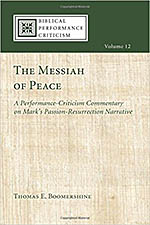Book Review: The Messiah of Peace: A Performance-Criticism Commentary on Mark’s Passion-Resurrection Narrative by Thomas E. Boomershine
Thomas E. Boomershine, The Messiah of Peace: A Performance-Criticism Commentary on Mark’s Passion-Resurrection Narrative.
Eugene, Oregon: Cascade Books, 2015. 448 pages/$57

What can a preacher learn from someone who has memorized the passion narrative of the Gospel of Mark and performed it over a period of forty-five years? A great deal! Thomas Boomershine has offered us a meticulous reading of the final three chapters of Mark. As he reconstructs the impact that this gospel had on those who first heard it performed, a very different set of conclusions arise from those embraced by much of contemporary scholarship.
Boomershine’s commentary begins with introductions to his themes. Hearing the gospel performed creates a different engagement than one experienced when reading a page silently. Preachers who have been reluctant to send a written copy of a sermon to someone will know that the change in medium alters everything. Boomershine invites us to reflect on the implications of this lived-experience for gospel interpretation. The gospels are compositions that depend on structures of sound for their rhetorical architecture. As black preaching depends on rhythm, cadences, and sonic echoes to drive home its message, so this proclamation from the ancient world is only understood when we get an ear-full of it. When the passion narrative of this gospel is performed, we overhear a peace-seeking word that invited the Judean people it addressed to reflect on the violence of the recent war (66 to 70 CE) and the national catastrophe that followed it. A storyteller who shares their national history and religious location convicted and invited them to reflect on their choice of the violence of warfare. Yet the storyteller does not end with conviction, but with the hope that they might embrace a different way of being in the world, a way that makes for peace. The life of Jesus, the Messiah of peace, reveals this way and his death and resurrection seal the deal.
The commentary brings several elements to each passage. Boomershine maps the sound patterns of the Greek with a translation in English so that we can see the shape of what was once heard. He offers a free website with digital recordings of performances of each text in both Greek and English (www.messiahofpeace.com). Boomershine discusses connections to other ancient stories (the stories of the Maccabean martyrs prove particularly fruitful). He offers the verse-by-verse observations we expect from a commentary. Preachers will find many insights that reshape the hearing of the stories. Two examples: the taunting of Jesus by the cohort becomes a spectacle when one knows the cohort included 600 soldiers; the extent of torture becomes painfully obvious when they “carry” him (rather than “bring” him) to Golgotha.
What does Boomershine mean by “Messiah of Peace”? Although the commentary focuses upon Jesus’ death, that death is meaningless without understanding his life. Jesus brought healing to broken people, reached across trenches separating insider from outsider, fed the hungry, and, in particular, did good for both his own people and their Gentile enemies. In Jerusalem Jesus staged a non-violent protest in the Temple recalling its need to serve “all the nations.” His death follows this event. Unlike the messianic David, Jesus consistently responded to enemies with peace, not warfare. When the hostilities were pointedly direct at his trial and crucifixion, Jesus, in keeping with his ministry, responds to this violence with non-violence.
The death of Jesus carries multiple echoes that make its interpretation complex. Boomershine consistently asserts that the death of Jesus is in keeping with the will of God. Yet he writes, “while there have been clues to God’s purposes in the events of Jesus’ suffering, what precisely God has in mind remains shrouded in mystery…” (277). At different times, Mark speaks of it as fulfillment of prophecy, an echo of the Passover sacrifice, a prophet’s death, an offering like Moses sprinkling blood on the Israelites, and martyrdom. Each of these makes different sense of how this is the will of God and what Jesus’ death means. I’d prefer to say that the extent to which the death is the will of God even remains a mystery.
But when Boomershine turns from what happens on the cross itself to the impact it has on hearers, he hears less mystery. The narrative creates “a dynamic of interaction and sympathetic participation” (9) by which the audience members identify with the characters who betrayed and denied Jesus opting for the violent Barabbas instead. They themselves feel implicated because they too have turned against peace in favor of hostility toward enemies and other outsiders. The narrative calls the audience to follow Jesus’ way of peace.
Readers of this commentary will find much to enrich their own practices both in everyday life and the pulpit. However, some of the benefit for preachers, at least those using the lectionary, will be indirect as their understanding of the gospel as a whole is reformed. As important as the cross has been in Christian theology, the RCL surprises us by including passages from Mark 14 to 16 only twice in the Sundays of year B (much of the passion narrative on Passion Sunday and Mark’s resurrection narrative as an option for Easter Sunday). This leads to two suggestions, one for the preacher and the other for Boomershine. Preachers might offer a sermon series on this passion narrative using Boomershine as a guide for their preaching. In turn, Boomershine might add an index of all Markan texts cited throughout the book in the next edition, since hardly a page lacks such references. So, when preaching on the baptism of Jesus, John’s beheading, or Jesus’ passion predictions, we might hear how the death of Jesus crystalizes his teaching and ministry and how that ministry leads to his death and resurrection. We can proclaim this in such a way that our hearers are led to live in Jesus’ way of peaceful, non-violent responses to our enemies.


